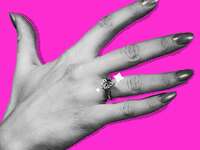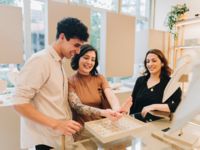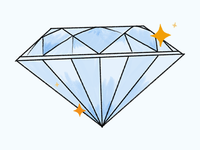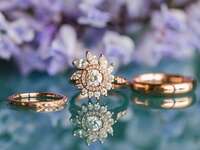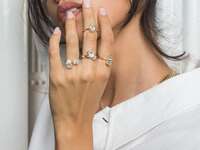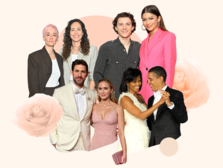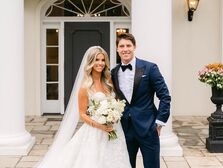How To Buy an Engagement Ring Your Partner Will Actually Love
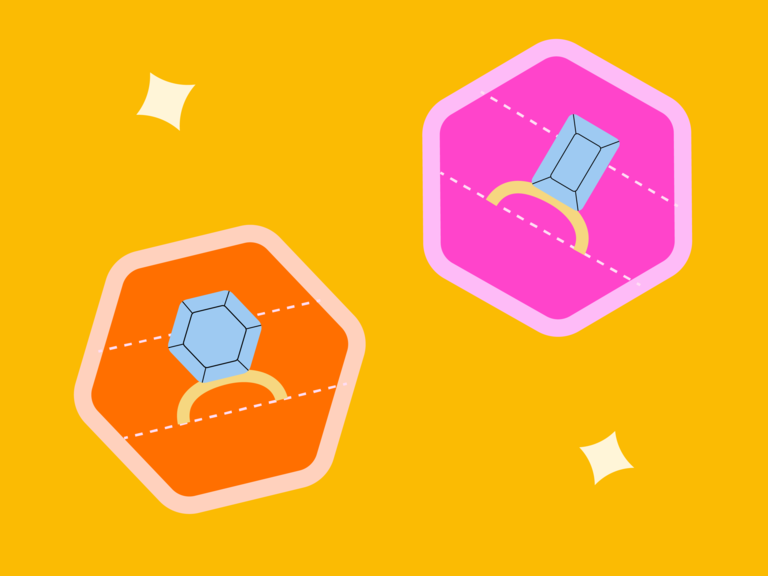
Planning the perfect proposal is a momentous task in itself and then on top of it, you have to figure out how to buy an engagement ring. If you think about it, the ring that you pick is going to be on your partner's ring finger through it all. So, it's worth finding something that your partner is going to love and luckily, it's become easier than ever. These days, couples prefer to shop for the engagement ring together. In fact, The Knot 2023 Jewelry and Engagement Study shows that 78% of those proposed to are involved in selecting their ring, while 28% of couples said that they intentionally looked at rings together before the proposal.
So whether you want shopping for an engagement ring to be a shared experience or are keeping the selection a total surprise, how does finding your perfect engagement ring work? If you and your partner are just beginning the ring-buying process, don't fret because below we're diving into all the engagement ring basics. From the engagement ring buying steps you need to take before swiping your credit card to understanding the 4C's so you can make an educated choice when buying your perfect sparkler, our engagement ring guide is here to answer all of your questions.
The Knot Engagement Ring Buying Steps
- Determine your budget - It's essential to establish a budget that aligns with your financial comfort zone. If this isn't a surprise, have an open and honest conversation with your partner to discuss the numbers. Remember, love doesn't have to break the bank!
- Research ring styles. Are you drawn to classic and timeless designs, or perhaps you prefer something more modern and unique? From classic solitaires to dazzling halos, take your time to research and find the design that reflects your partner's personal style and captures the essence of your love story.
- Choose a reputable jeweler. Find a trusted jeweler who can guide you through the process, answer your questions and provide expert advice. Seek out jewelers on The Knot Vendor Marketplace who have a track record of exceptional service, quality craftsmanship and ethical practices.
- Choose a Center Diamond or Gemstone. This is the heart of the ring. Do you have your heart set on a dazzling diamond, or maybe you prefer the allure of a colored gemstone like a sapphire, emerald or ruby? Explore your options and consult with your jeweler on the best option for you.
- Choose your ring setting. The setting of your engagement ring is like the stage that showcases the center diamond or gemstone. Consider your lifestyle, personal style, and the stone you've chosen when selecting the perfect setting. Whether it's a classic prong setting or an art-deco-inspired vintage setting, let the setting enhance the beauty of your chosen stone.
- Choose your ring metal. From white gold to rose gold, platinum to yellow gold, there's a myriad of metal options to choose from. Think about your personal style and preferences when selecting the metal for your engagement ring.
- Purchase and Insure Your Ring. Once you've found the perfect ring, it's time to seal the deal but don't forget to inquire about insurance options. Your engagement ring is an investment that holds immense sentimental value, so it's essential to protect it against the uncertainties of life.
- Propose! With the ring safely in your possession, it's time for the the proposal. Take a deep breath, plan a meaningful and romantic proposal, and let the magic unfold. Remember, this is a once-in-a-lifetime moment, so savor every second and celebrate the beginning of this exciting journey together.
Understanding Engagement Ring Basics
Now that you've got an overivew of the buying process, it's time to dive into understanding the engagement ring basics. Arguably the most important part of our engagement ring guide, this simplified section will help you easily understand the three crucial elements to consider: stones, settings and metals (aka the anatmoy of an engagement ring) so you can make an informed decision when buying your engagment ring:
The 4Cs
A diamond is a big-ticket purchase, so it's important to know what you're paying for. The 4Cs—cut, color, clarity, and carat weight—are globally accepted grading standards developed by the Gemological Institute of America (GIA) to determine a diamond's overall quality and price.
Cut: The most important of the 4Cs, the cut refers to how well a diamond refracts light, aka how sparkly a diamond is. Note that the cut is not to be confused with a diamond shape (like round, oval, etc.) but rather it evaluates how well a diamond is cut and polished. It can be rated from poor to excellent.
Color: The color of a diamond refers to how yellow or white it appears. Ranges from D (colorless) to Z (light yellow). The closer a diamond is to "colorless," the rarer it is and thus more expensive. Many jewelers suggest that diamonds ranging from G-J will give you the best value for your buck.
Clarity: Clarity refers to how many imperfections (also known as inclusions or blemishes) are in the diamond. While a stone's clarity matters, it's also important to note that you can find plenty of diamonds that are "clean to the eye" or stones that may not be perfect but look flawless to the naked eye. This rating ranges from included to flawless.
Carat: The carat is the weight of the diamond. The larger the carat weight, the more rare and thus expensive the stone is.
The Difference Between Natural and Lab-Grown Diamonds
The main difference between a natural diamond and a lab-grown diamond is how they were created. As the name suggests, Natural diamonds are made in the earth, while lab-grown diamonds are created in a sterile laboratory setting. And yes, lab-grown diamonds are real diamonds. While natural diamonds and lab-grown diamonds come from different places, they are physically, chemically and optically the same. Lab-grown diamonds are anywhere from 30% to 50% less expensive than mined diamonds due to their origin and collection process. Want to know more? Check out a complete rundown on lab-grown diamonds here.
Alternative Engagement Ring Stones
More couples are looking for nontraditional engagement ring options that express their personal style, so it's no surprise that non-diamond engagement rings featuring precious and gemstone rings are on the rise. According to The Knot 2023 Jewelry and Engagement Study, 10% of couples opt for an engagement ring with a non-diamond center stone. A big pro of opting for an alternative engagement ring? Gemstones tend to be less expensive than diamonds of a similar size and come in a wide variety of hues, each with its own special meaning. Just make sure you do your gemstone research and avoid stones that are soft (read: easily cracked or chipped).
Pro tip: Look for a stone that's at least 7 on the Moh's scale, which measures a stone's hardness and durability.
Engagement Ring Settings
The engagement ring setting refers to the actual ring it self that the diamond sits in. Your ring setting is not only a stylistic choice, but it has the important job of holding your diamond in place. Below is a fw of the most popular engagement ring settings, but if you want to see moree, you can check out our comprehensive ring setting guide here.
Prong Setting: Designed for solitaire rings (read: a ring with a single center stone, no accent stones or a halo), a prong setting features four to six prongs that hold a center stone in place. Because a solitaire engagement ring is one of the simplest settings, it puts the focus directly on your center stone. Opting for six prongs will maximize the security of your diamond, while four prongs is a classic choice if you have a smaller stone that could be overwhelmed by additional prongs.
Pavé Setting: From the French word for "paved," a pavé diamond setting involves rows of several tiny stones that are set level with the surface of the ring. The surrounding metal is raised to form beads that secure the gems. The result is an ultra-sparkly setting that looks like a road paved with gemstones.
Halo Setting: Halo engagement ring settings have a "halo" of tiny diamonds, known as pavé or micropavé accent stones, that circle around a larger stone. A halo setting is also one of the most popular styles when it comes to engagement rings, particularly because it creates the illusion of a larger diamond.
Cathedral Setting: As one of the more sophisticated diamond ring settings, a cathedral style uses sweeping arcs that extend from the shank to frame the center stone, to create a beautiful focal point for the ring. This elegant setting tends to sit higher on your finger and allows for extra details on the crown of the ring.
Bezel Setting: Bezel settings are one of the hottest engagement ring trends at the moment. This stylish option has a ring of metal that either partially or fully around the center stone. This sleek setting tends to have a lower profile (meaning it sits lower on your finger) and protects a diamond from snags or chips because of how secure it is. Did I mention that it's perfect for those who have an active lifestyle?
Types of Engagement Ring Metals
Not all metals are created equal. Whether you opt for classic white or yellow gold, luxe platinum or trendy rose gold, you should know how the metal you choose will affect your ring's durability and overall aesthetic. Here's a brief breakdown of some of the most popular engagement ring metals is below. You can also take a deep dive with our engagement ring metals guide here.
White Gold: The most popular engagement ring metal, white gold has a silver-like finish similar to platinum. White gold is a combination of yellow gold and alloys that is then plated in rhodium. Because its bright finish comes from rhodium plating, it does require consistent upkeep to preserve its gorgeous finish.
Yellow Gold: As the purest of all gold ring metal types, a yellow gold engagement ring or band is the most hypoallergenic and the easiest to maintain. Its warmer tones are ultra-flattering and work well with diamonds of a lower color grade. And its popularity is also on the rise. According to The Knot 2023 Jewelry and Engagement Study, one in four engagement rings is yellow gold.
Rose Gold: Like its name implies, rose gold metal has a gold base with a pinkish tint. It's an alloy that's made by combining pure gold, copper and a hint of silver. The higher the copper content, the pinker the rose gold. Thanks to its distinct pink hue, rose gold is an inherently romantic option for those who don't want a white or yellow gold ring.
Platinum: Platinum is the most durable engagement ring metal, as well as the purest. While this pure white metal can still show dings and scratches, it loses less metal mass over the years when compared to gold. Platinum is also one of the best metals for engagement rings because it won't tarnish over time. With that kind of durability, platinum is easily the most expensive of all the engagement ring metals.
Understanding Engagement Ring Cost
No matter the center stone, metal or ring setting you choose, an engagement ring is an investment. Setting a ring budget will help you narrow down your search and prioritize what aspects of an engagement ring matter most to you. With that said, the three-month salary rule no longer applies—your ring budget should be determined by your comfort level. According to The Knot 2023 Jewelry and Engagement Study, the average cost of an engagement ring is currently about $5,500. While $5,500 is the national average cost of a ring, the cost per couple varies. Our study found that nearly half of all respondents are spending between $1,000 to $4,000 on their engagement ring. In fact, 9% of ring shoppers are spending under $1,000. However, outside of the diamond itself, a few different factors go into what makes up this total cost of an engagement ring:
Stone(s): Your stones of choice will likely make up the majority of your ring cost. This not only includes your center diamond or gemstone, but also any diamonds that are added to the setting as well.
Settings: Most engagement ring settings cost an average of $500 to $1,500. The type of metal, stone inclusions, design and customizations can all effect the cost of your setting.
Customizations: Are you adding any personalizations. or engraving? Are you creating a custom engagement ring? This can likely impact the overall price of your ring verus going with a traditional pick.
Taxes and Fees: Who can forget the taxes and fees? These numbers vary based on your jeweler and the state you are doing business in. Always ask to see a full breakdown and explanation of price with taxes and fees before proceeding with a transaction.
Insurance: Do not pass go without engagement ring insurance! This is a big purchase and you want to make sure it is protected in the event of loss, damage or theft. This is purchased seperately from the ring, but it is something you should take in to account and discuss with your jewelry. The insurance cost shouild be around .5% to 2% of its appraised value. Read our full engagement ring insurance guide here.
Where to Buy an Engagement Ring
Now that you've read through our guide for how to buy an engagement ring, it's time to talk about where to buy an engagement ring. Luckily, there are so many different options for your buying experience based on your shopping preferences from online engagement ring retailers to national chains and local jewelers you can find on The Knot Vendor Marketplace. Here's a few favorites to get you started:
National Chains
Kay Jewelers: For over a hundred years, Kay Jewelers has been a go-to destination for fine jewelry. With over 1,000 stores, this national chain carries a wide range of engagement ring and wedding ring designs from notable designers and brands like Neil Lane, Adrianna Papel and The Leo Diamond. It's a savvy choice too, with options starting at under $100.
Jared: With over 200 stores and hundreds of options to choose from, Jared offers a seemingly endless supply of engagement rings, wedding rings and fashion jewelry from trusted designers like Vera Wang, Neil Lane, Forevermark and Tacori. Options start at just $75 and go up from there.
Zales: Established in 1924, Zales has been in the business for almost a decade—and with good reason. The jewelry store offers a range of popular wedding and engagement ring collections from Vera Wang LOVE, Enchanted Disney Fine Jewelry and Marilyn Monroe. And, similar to Kay Jewelers and Jared, Zales keeps their offerings budget-friendly.
Independent Jewelers
Ashley Zhang: Calling all vintage lovers. Ashley Zhang offers a collection of both vintage pieces and new designs, made for the couple looking for an engagement ring with modern heirloom appeal. Ranging from delicate 14K pieces to large, high-quality diamonds, this jeweler offers something for an array of budgets and aesthetics.
Blue Nile: Founded in 1990, Blue Nile is an established e-commerce destination for loose stones as well as diamond and gemstone jewelry. It launched lab-grown diamond jewelry in 2020, in collaboration with the brand Lightbox.
Brilliant Earth: If you're looking to design a ring from start to finish, Brilliant Earth is an excellent resource. You simply pick your preferred lab-grown diamond, select a setting from dozens of options, and finish off by choosing from white gold, yellow gold, rose gold or platinum. And they also offer unisex ring options.
Catbird: One of the OG sites for bohemian engagement rings, Catbird offers unique options for couples with less traditional tastes (including unisex and men's styles). Delicate center stones, alternative engagement rings and vintage-inspired designs make up this more eclectic collection.
Forevermark: A diamond brand from De Beers Group, Forevermark boasts over 130 years of diamond expertise and approximately 450 independent jewelers in the US. Every Forevermark diamond is natural and conflict-free, as well as cut and polished by master craftsmen.
Gemist: As one of the first digital platforms to allow users to custom-design rings and try them on at home before making a purchase, Gemist is changing the direct-to-consumer engagement ring space. Choose from settings and styles, and then customize your piece by selecting your preferred metal, gemstone and stone shape.
Grown Brilliance: This lab-grown diamond brand is new to the scene but is already making a splash. Offering both loose lab-grown diamonds, lab-grown diamond engagement rings and lab-grown diamond jewelry, Grown Brilliance styles run the gamut from classic to über-luxe, for a fraction of the cost of what you'd spend on natural diamond jewelry.
James Allen: The largest privately held diamond and jewelry retailer in the world, James Allen offers a selection of over 500,000 diamonds—both natural and lab-grown. If you're looking to go the more custom route, check out the site's Ring Studio, where you can choose a ring with the center stone, setting and metal of your choosing.
Jean Dousset: Known for upscale natural diamond engagement rings, Jean Dousset launched Oui by Jean Dousset, a lab-grown engagement ring collection, in 2021. The line offers the same luxe craftsmanship as Jean Dousset at a more accessible price point.
KatKim: This LA-based brand designed by Katherine Kim is all about clean lines and unexpected silhouettes (think: Toi et Moi designs, abstract settings and reimagined statement bands). Sustainability is a core pillar of the KatKim; all of the pieces are handmade by artisans and use exclusively ethical stones as well as recycled metals when possible.
Kwiat: If you're willing to splurge on exceptional quality, look no further. Owned and operated by the Kwiat family since 1907, Kwiat is one of the most iconic jewelers in New York, known for their superior quality and craftsmanship. Fun fact: Their store on 47th Street was one of the first in what is now called the Diamond District, an international destination for diamond and jewelry buying. Today, the brand has a flagship store on Madison Avenue and is celebrating over 110 years in the jewelry industry.
Ritani: Ritani is known for its large inventory of lab-grown and natural diamonds in every cut and carat weight, as well as settings in a seemingly endless amount of styles. With price points starting at around $300 for a setting, Ritani's collection has something for every budget.
Vrai: Vrai uses lab-grown diamonds from a zero-emission foundry in the Pacific Northwest of the United States. As one of the first trendy jewelers to bring lab-grown diamonds into the mainstream in 2014, they offer a variety of stone shapes and settings—from classic to more edgy.
Looking for more? Find local jewelry stores near you.



